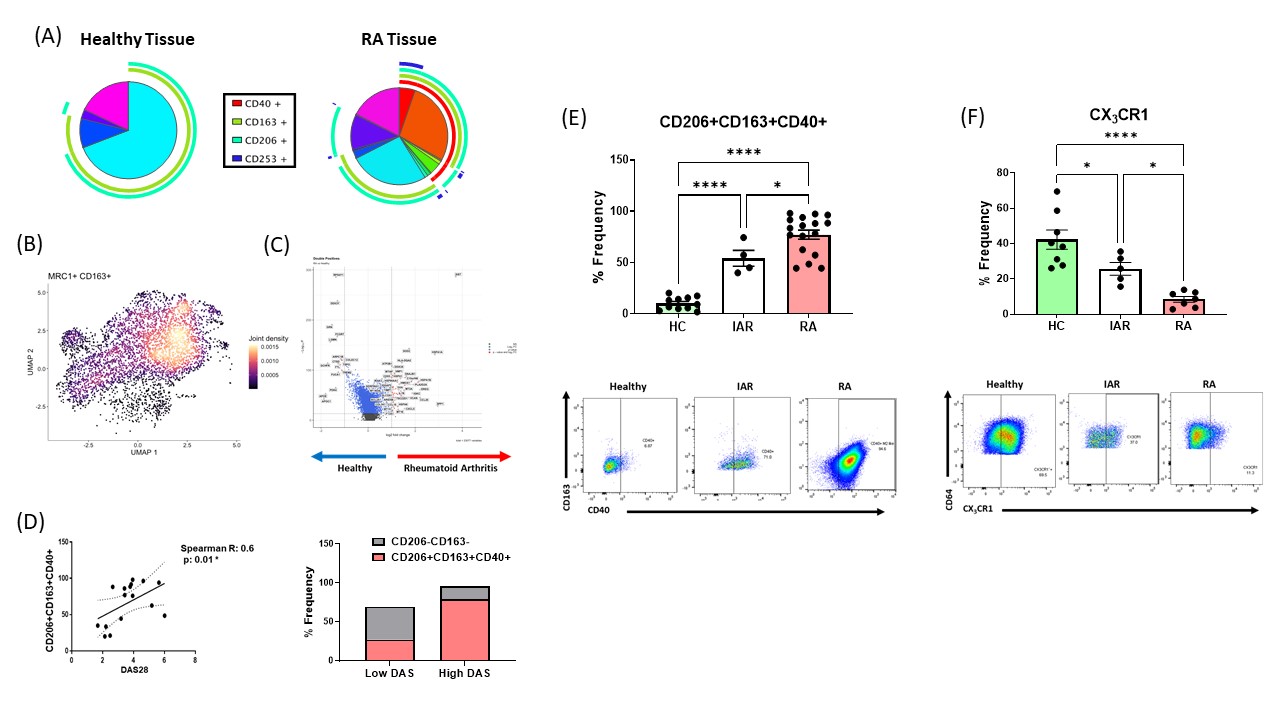Back
Abstract Session
Immunobiology
Session: Abstracts: Innate Immunity (0554–0557)
0554: Loss of Synovial Tissue Macrophage Homeostasis Precedes Rheumatoid Arthritis Clinical Onset
Saturday, November 12, 2022
5:00 PM – 5:10 PM Eastern Time
Location: Room 114 Nutter Theatre
- MH
Megan Hanlon, PhD, BSc
Molecular Rheumatology
Dublin, Dublin, Ireland
Presenting Author(s)
Megan Hanlon1, Mary Canavan2, conor Smith3, Achilleas Floudas4, Nuno Neto5, Qingxuan Song6, Phil Gallagher7, Ronan Mullan8, Conor Hurson9, Barry Moran5, Michael Monaghan5, Sunil Nagpal10, Douglas Veale11 and Ursula Fearon5, 1Molecular Rheumatology, Dublin, Ireland, 2Trinity College, Dublin, Ireland, 3bTrinity College Dublin, Dublin, Ireland, 4Molecular Rheumatology Trinity Biomedical Sciences Institute, Dublin, Ireland, 5Trinity College Dublin, Dublin, Ireland, 6Janssen Research and Development, LLC, Spring House, PA, 7St Vincent's University Hospital, Dublin, Ireland, 8Tallaght University Hospital, Dublin, Ireland, 9St Vincents University Hospital, Dublin, Ireland, 10Janssen Research, Collegeville, PA, 11St. Vincent's University Hospital, Blackrock, Dublin, Ireland
Background/Purpose: Synovial-tissue macrophages significantly contribute to Rheumatoid Arthritis, yet the precise nature/function of macrophage subsets within the inflamed joint remains unexplored. Here we explore the spectrum of distinct macrophage activation states residing within the synovium of RA, at risk and healthy individuals.
Methods: Single-cell synovial-tissue suspensions from RA(n=44), IAR(n=5), HC(n=11) were obtained, synovial macrophage subsets examined by advanced flow-cytometric analysis, single-cell/bulk RNA-sequencing, metabolic and functional assays.
Results: Multidimensional analysis identifies enrichment of CD206+CD163+ synovial-tissue macrophages co-expressing CD40 in RA compared to healthy synovial-tissue, with frequency of CD206+CD163+CD40+ macrophages associated with increased disease activity and treatment response. In contrast, CX3CR1-expressing macrophages enriched in healthy synovium are significantly depleted in RA. Importantly this signature of enriched CD40 expression coupled with depleted CX3CR1 expression is an early phenomenon, occurring prior to clinical manifestation of disease in individuals 'at-risk' of RA (IAR). In-depth RNAseq and metabolic profiling of sorted RA synovial-macrophages identified that this population is transcriptionally distinct, displaying unique inflammatory, phagocytic and tissue-resident gene signatures, paralleled by a bioenergetically stable profile as indicated by NAD(P)H emission. Functionally CD206+CD163+ RA macrophages are potent producers of pro-inflammatory mediators (reversed by CD40-signalling inhibition) and induce an invasive phenotype in healthy synovial-fibroblasts. These findings identify a distinct pathogenic population of synovial-tissue macrophage involved in shaping the immune response in RA.
Conclusion: We have identified a novel population of tissue-resident macrophages in the RA synovium which are transcriptionally/metabolically distinct and capable of contributing to disease pathology. Crucially, this signature is present pre-disease representing a unique opportunity for early diagnosis and therapeutic intervention.
 Pathogenic synovial tissue macrophage signature predates clinical manifestations of disease
Pathogenic synovial tissue macrophage signature predates clinical manifestations of disease
Disclosures: M. Hanlon, None; M. Canavan, None; c. Smith, None; A. Floudas, None; N. Neto, None; Q. Song, Janssen Research & Development, LLC, Johnson & Johnson; P. Gallagher, None; R. Mullan, None; C. Hurson, None; B. Moran, None; M. Monaghan, None; S. Nagpal, Janssen; D. Veale, AbbVie/Abbott, Pfizer, Eli Lilly, Novartis, Gilead; U. Fearon, AbbVie/Abbott, Pfizer, Janssen, Eli Lilly, GlaxoSmithKlein(GSK).
Background/Purpose: Synovial-tissue macrophages significantly contribute to Rheumatoid Arthritis, yet the precise nature/function of macrophage subsets within the inflamed joint remains unexplored. Here we explore the spectrum of distinct macrophage activation states residing within the synovium of RA, at risk and healthy individuals.
Methods: Single-cell synovial-tissue suspensions from RA(n=44), IAR(n=5), HC(n=11) were obtained, synovial macrophage subsets examined by advanced flow-cytometric analysis, single-cell/bulk RNA-sequencing, metabolic and functional assays.
Results: Multidimensional analysis identifies enrichment of CD206+CD163+ synovial-tissue macrophages co-expressing CD40 in RA compared to healthy synovial-tissue, with frequency of CD206+CD163+CD40+ macrophages associated with increased disease activity and treatment response. In contrast, CX3CR1-expressing macrophages enriched in healthy synovium are significantly depleted in RA. Importantly this signature of enriched CD40 expression coupled with depleted CX3CR1 expression is an early phenomenon, occurring prior to clinical manifestation of disease in individuals 'at-risk' of RA (IAR). In-depth RNAseq and metabolic profiling of sorted RA synovial-macrophages identified that this population is transcriptionally distinct, displaying unique inflammatory, phagocytic and tissue-resident gene signatures, paralleled by a bioenergetically stable profile as indicated by NAD(P)H emission. Functionally CD206+CD163+ RA macrophages are potent producers of pro-inflammatory mediators (reversed by CD40-signalling inhibition) and induce an invasive phenotype in healthy synovial-fibroblasts. These findings identify a distinct pathogenic population of synovial-tissue macrophage involved in shaping the immune response in RA.
Conclusion: We have identified a novel population of tissue-resident macrophages in the RA synovium which are transcriptionally/metabolically distinct and capable of contributing to disease pathology. Crucially, this signature is present pre-disease representing a unique opportunity for early diagnosis and therapeutic intervention.
 Pathogenic synovial tissue macrophage signature predates clinical manifestations of disease
Pathogenic synovial tissue macrophage signature predates clinical manifestations of disease Disclosures: M. Hanlon, None; M. Canavan, None; c. Smith, None; A. Floudas, None; N. Neto, None; Q. Song, Janssen Research & Development, LLC, Johnson & Johnson; P. Gallagher, None; R. Mullan, None; C. Hurson, None; B. Moran, None; M. Monaghan, None; S. Nagpal, Janssen; D. Veale, AbbVie/Abbott, Pfizer, Eli Lilly, Novartis, Gilead; U. Fearon, AbbVie/Abbott, Pfizer, Janssen, Eli Lilly, GlaxoSmithKlein(GSK).

